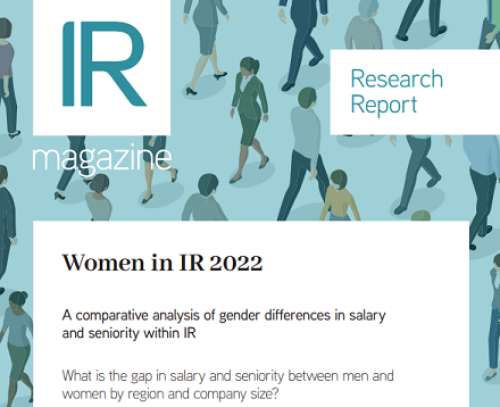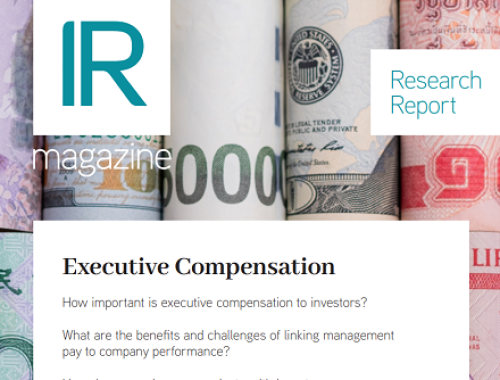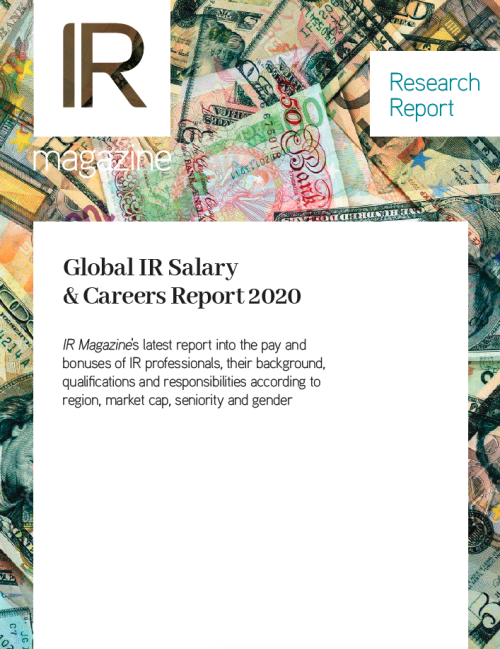IR professionals are out on the road – physically or virtually – they market to new investors and maintain the shareholder base with hundreds of investor meetings a year. They are the eyes and ears of the C-suite on the Street and an essential element of defense should an activist shareholder or short-seller show up on the register. So why don’t IR roles command a higher salary? This conversation might be less about salary and compensation and more about proving the value of IR – but where IR is valued, it is often better compensated (budgets allowing).
So what are IR professionals earning? According to the IR Magazine Global IR Salary & Careers Report 2020, the global median salary range for IR heads is $150,000-$199,999 and $75,000-$99,999 for IR officers. But that has remained unchanged since 2017 and there are a number of variants behind the median. Larger market-cap companies tend to offer higher salaries, for example, and IR professionals in North America are paid the most globally: 41 percent of IR heads in the region take home between $250,000 and $349,000 before a bonus, and 39 percent of IROs fall into the $150,000-$199,999 pay bracket.
Those in Asia are paid significantly less: 55 percent of IR heads there take home $100,000-$149,000, while 58 percent of the region’s IR officers have a salary of less than $50,000.
‘There are a number of different factors that affect compensation,’ explains Smooch Repovich Reynolds, managing partner at ZRG Partners, with length of time in the role, career path into IR and any additional responsibilities all playing a part. But investor relations isn’t something people specifically train for.
‘This profession is still a combination of many different backgrounds,’ explains Repovich Reynolds. ‘People don’t go to college or university and say, I want to study IR. They fall into it at some point in their career.’ This doesn’t go unnoticed by management and is something Steve Rubis, a former sell-sider turned IR professional, says can limit compensation. ‘Many executives view IR as a utility position,’ he notes. ‘Many companies see it as rotational, a training ground for a higher-level finance job. But viewing IR as rotational limits its perceived value as a value-add contributor to the C-suite.’
He adds that at some firms, the value of IR is recognized only once an activist or short-seller shows up in the stock: 'The definition of good investor relations can be more subjective than one might realize.'
A young profession
Aside from the personal specifics of an IRO’s career path or the company he or she works for, Repovich Reynolds also notes the youthfulness of IR as a profession. ‘If you think about a chief general counsel, for example, that profession has been around for more than 100 years,’ she says. ‘IR – as a formal, bona fide profession – has been around for just 35 years.’
But while IR’s relative newness might impact compensation today, it also means the role is still evolving: from one that was closer to PR and communications to one focused on finance and now moving toward a greater focus on strategy. What this means in turn is that compensation is also evolving.
IR professionals need to think outside of IR, says Repovich Reynolds. ‘It’s human nature to check off a list, right?' she says. 'I have 10 responsibilities and if I do those 10 responsibilities then I should either be promoted or get paid more. But what people miss is that if you want to be highly compensated, you have to be viewed as a senior business executive leader in the organization as much as you are an IR officer.’
So how do you do this? Adding new areas of expertise and responsibility is the route many are taking, adding finance, treasury, ESG, strategy or corporate responsibility to the IR role. ‘When you bundle areas of responsibility, it drives compensation up,’ says Repovich Reynolds. In fact, the IR Magazine Salary & Careers Report 2020 shows that 70 percent of investor relations professionals also hold non-IR responsibilities. Corporate communications is the most common additional duty at 36 percent, but just under a quarter have responsibility for corporate strategy as well as IR.
This is an extract of a feature from the Winter 2020 issue of IR Magazine. Click here to read the full article.










